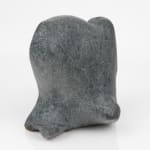-
Artworks
JOHN PANGNARK (1920-1980) ARVIAT (ESKIMO POINT)
Mother and Child, c. 1975stone, 5.5 x 5 x 3.75 in (14 x 12.7 x 9.5 cm)
unsigned.1Further images
John Pangnark rose to prominence in the Arviat art scene through his minimalist approach to sculpture, which art historian George Swinton famously compared to the work of Constantin Brâncuși. Swinton...John Pangnark rose to prominence in the Arviat art scene through his minimalist approach to sculpture, which art historian George Swinton famously compared to the work of Constantin Brâncuși. Swinton admired Pangnark’s ability to distill forms to their purest essence, an approach that resonated with the austere aesthetic of Arviat sculpture, marked by its formal sensitivity and geometric abstraction. While Pangnark is often celebrated as Inuit art’s most minimalist and abstract practitioner, his style was far from static. It shifted fluidly between figural and abstract, geometric and free-form.
In the mid to late 1960s, Pangnark’s works often balanced figural representation with geometric rigor, while his works from the early-mid 1970s embraced high abstraction, their forms shaped by the natural contours of the stone. By 1975, however, Pangnark’s style transformed once again. This Mother and Child, a compelling example of his later free-form work, illustrates this shift. Here, Pangnark forgoes working strictly with the natural shape of the stone, treating it more like clay to create smooth, rounded forms. The figures—heads, arms, legs—appear squeezed and stretched into being, biomorphic in their fluidity, as though the solid stone had taken on the lightness of an inflated balloon sculpture.
Provenance
Galerie Elca London, Knowlton, QC.1of 30
Join our mailing list
* denotes required fields
We will process the personal data you have supplied in accordance with our privacy policy (available on request). You can unsubscribe or change your preferences at any time by clicking the link in our emails.












